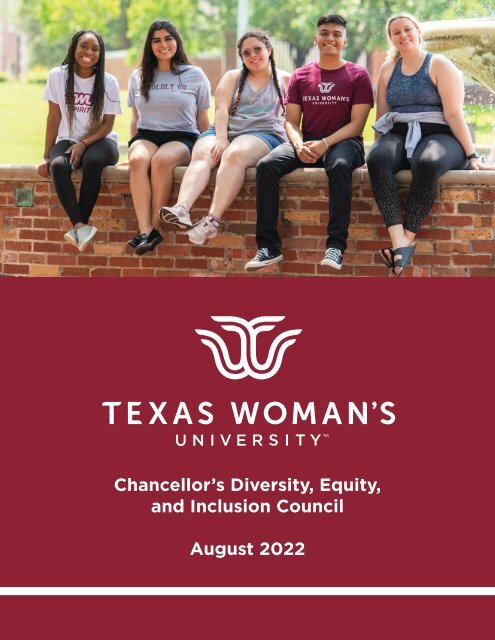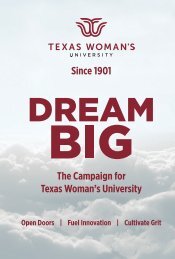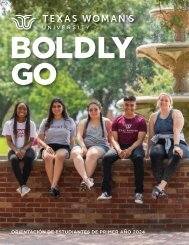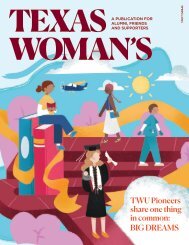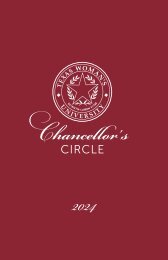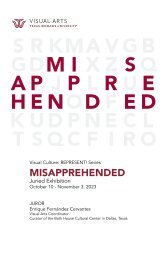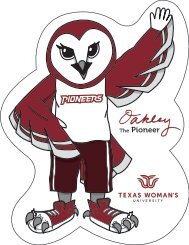Diversity, Equity and Inclusion Annual Report 2022
You also want an ePaper? Increase the reach of your titles
YUMPU automatically turns print PDFs into web optimized ePapers that Google loves.
Chancellor’s <strong>Diversity</strong>, <strong>Equity</strong>,<br />
<strong>and</strong> <strong>Inclusion</strong> Council<br />
August <strong>2022</strong><br />
18
Table of contents<br />
Introduction………………………………………………….....................................…………………… 1<br />
Who TWU Looks Like..…………………………………………….................................…………… 2<br />
Definitions of Terms.………………………………………………….................................……..….. 5<br />
Frameworks we Used……………………………………..................................…………………..… 6<br />
How We Collected Data................................................................................................. 7<br />
Methodology……………………………………………...................................………………………... 8<br />
Qualitative Data ……………………….................................………………………………………….. 9<br />
Where We Are Today………………................................…………………………………………… 10<br />
Our Findings <strong>and</strong> Recommendations……….........................……………………….………… 11<br />
Our Progress <strong>and</strong> Our Path Forward……….........................………………………….…….… 17
Introduction<br />
The Chancellor’s <strong>Diversity</strong>, <strong>Equity</strong> <strong>and</strong> <strong>Inclusion</strong> Council (CDEIC) at Texas Woman’s University was launched in<br />
December of 2020 to share information, generate new ideas, <strong>and</strong> provide recommendations to the Chancellor’s<br />
Cabinet regarding st<strong>and</strong>ardized, fair, <strong>and</strong> objective diversity, equity <strong>and</strong> inclusion (DEI) practices for all employees.<br />
The Chancellor’s Cabinet uses this data to inform their decisions <strong>and</strong> policies for the university. Through exploration<br />
<strong>and</strong> research, members of the CDEIC also educate the TWU community about:<br />
• <strong>Diversity</strong>, equity, <strong>and</strong> inclusion, broadly;<br />
• Specific DEI programming, strategies, <strong>and</strong> tactics from various levels of the organization;<br />
• Fair <strong>and</strong> equitable treatment of employees;<br />
• Promising practices for the recruitment <strong>and</strong> retention of underrepresented faculty <strong>and</strong> staff; <strong>and</strong><br />
• Equal access to professional opportunities <strong>and</strong> advancement for underrepresented faculty <strong>and</strong> staff.<br />
Who sits on the DEIC?<br />
• Chair with a three-year term<br />
• Faculty <strong>and</strong> staff employees<br />
• Representation from<br />
all three campuses<br />
• TWU student regent<br />
• Leaders from affinity groups<br />
<strong>and</strong> college diversity committees<br />
*Membership rotates with the leadership rotation of the respective employee resource group,<br />
college DEI committee, office, division, or program<br />
1
Who TWU looks like – Our Students*<br />
The Latinx/ Hispanic student population doubled since 2009, <strong>and</strong> comprises the largest number of non-White<br />
students at all three campuses. *Averaged across all three campuses as of Fall 2021, 27.6% of our undergraduate<br />
students <strong>and</strong> 19.6% of our graduate students self-identify as Hispanic or Latinx; 11.6% of our undergraduate students<br />
<strong>and</strong> 15.7% of our graduate students self-identify as African-American or Black; 19.1% of our undergraduate students<br />
<strong>and</strong> 14.1% of our graduate students self-identify as Asian; 34.4% of our undergraduate students <strong>and</strong> 44% of our<br />
graduate students self-identify as White; <strong>and</strong> 7.1% of our undergraduate students <strong>and</strong> 6.4% of our graduate students<br />
self-identify as Other.<br />
*This data was adapted from secondary sources from the Office of Institutional Research that align with the U.S.<br />
Census Bureau data categories at the time it were collected. The CDEIC recognizes <strong>and</strong> acknowledges that race is a<br />
social construct <strong>and</strong> the identity group labels we used to describe our TWU demographics are incomplete <strong>and</strong> do not<br />
fully describe or address the complexity of the variety of ethnic or racial backgrounds that exist.<br />
2
Who TWU looks like – Our Employees*<br />
Averaged across all three campuses as of Fall 2021, the TWU Office of Institutional Research <strong>and</strong> Data Management<br />
reports 11.3% of all of our employees (both faculty <strong>and</strong> staff) as Hispanic or Latinx; 17% as African-American or Black;<br />
19.3% as Other; <strong>and</strong> 52.3% as White.*<br />
Dallas Denton Houston<br />
In regards to TWU faculty, the Chronicle of Higher Education (<strong>2022</strong>) reports 6.5% of faculty as Latinx or Hispanic;<br />
7.0% as African- American or Black; 11.3% as Asian; 1.1% as American Indian or Alaska Native; 1.8% as Unknown; 0.7%<br />
as Native Hawaiian or Pacific Isl<strong>and</strong>er; <strong>and</strong> 73.4% as White. By comparison to other 4-year degree doctoral-granting<br />
institutions in the DFW or Houston area, TWU ranks 6th for overall diversity based on the total minority percentage<br />
for faculty.<br />
Race, Ethnicity, <strong>and</strong><br />
Gender of Full-Time<br />
Faculty Members<br />
at Four-Year Degree<br />
Doctoral Granting<br />
Institutions in DFW<br />
Region<br />
*This data was adapted from secondary sources from the Office of Institutional Research that align with the U.S.<br />
Census Bureau data categories at the time it were collected. The CDEIC recognizes <strong>and</strong> acknowledges that race is a<br />
social construct <strong>and</strong> the identity group labels we used to describe our TWU demographics are incomplete <strong>and</strong> do not<br />
fully describe or address the complexity of the variety of ethnic or racial backgrounds that exist.<br />
3
Who TWU looks like – Our Leadership<br />
Approximately 26.2% of the leadership roles at TWU are held by individuals<br />
from traditionally underrepresented racial identity groups<br />
4
Definition of Terms<br />
We define diversity, equity, <strong>and</strong> inclusion as follows:<br />
<strong>Diversity</strong> is the presence of differences that may include race, gender, religion, sexual orientation, ethnicity, nationality,<br />
socioeconomic status, language, (dis)ability, age, or religious commitment. When we discuss diversity, it is in regard to<br />
employees who have been - <strong>and</strong> remain - underrepresented in higher education <strong>and</strong> marginalized in the broader society.<br />
We captured race, ethnicity, gender, <strong>and</strong> sexual orientation of employees for this report.<br />
18<br />
<strong>Equity</strong> is promoting justice, impartiality <strong>and</strong> fairness within<br />
the procedures, processes, <strong>and</strong> distribution of resources by<br />
TWU. We recognize that tackling equity issues requires an<br />
underst<strong>and</strong>ing of the root causes of outcome disparities<br />
for employees which may not be salient on the surface.<br />
<strong>Inclusion</strong> refers to the degree to which employees are able<br />
to participate effectively at TWU. This includes having<br />
equal access to job- <strong>and</strong> duties-related information <strong>and</strong><br />
resources, being involved in the decision-making processes<br />
when relevant, <strong>and</strong> creating a sense of belonging for all<br />
employees.<br />
5
Frameworks we used<br />
Multicultural Organizational Development (MCOD) model<br />
Grounded in frameworks <strong>and</strong> theories from both organizational development <strong>and</strong> diversity in the workplace literature,<br />
the MCOD is a process model that identifies the strength of an organization’s climate of diversity. Based on what stage<br />
an organization is in, the MCOD process determines what organizational change interventions are needed.<br />
.<br />
Change team<br />
System<br />
Readiness<br />
Assessments<br />
Implement<br />
change<br />
Evaluate &<br />
Renew<br />
The six stages of development include:<br />
1 Exclusionary<br />
2 Club<br />
3 Compliance<br />
4 Affirming<br />
5 Redefining<br />
6 Multicultural<br />
Reaching Stage 6, the Multicultural Organization,<br />
should be the goal of organizational leadership.<br />
Multicultural<br />
Redefining<br />
Affirming<br />
Compliance<br />
club<br />
Exclusionary<br />
IMAGIN Framework<br />
Building on existing conceptualizations of change management, the IMAGIN framework provides an alternate<br />
explanation for the organizational change process by merging organizational development theories with DEI<br />
frameworks. (Lambert & Akinlade, 2020)<br />
6
How we collected data<br />
Over the past year (AY 2021-22), the CDEIC collected data in three ways:<br />
1. Focus Groups<br />
2. Leadership Questionnaires<br />
3. TWU system-wide employee surveys<br />
TWU Discovery Tour (Focus Groups)<br />
A series of virtual meetings were held across TWU to share with employees information about the CDEIC <strong>and</strong> to<br />
gather preliminary information about employees’ perceptions regarding the climate of DEI at TWU. The feedback<br />
served as a foundation from which the CDEIC began to examine DEI at TWU <strong>and</strong> create our survey instruments.<br />
The chair of the CDEIC met various stakeholder groups including but not limited to:<br />
Affinity Groups | Faculty Senate | Staff Council Academic Affairs | Ombudsperson<br />
Student Life | Human Resources | Center for Faculty Excellence<br />
TWU Organization Readiness Leadership Questionnaire<br />
The Organization Readiness Questionnaire captures the perspectives, perceptions, <strong>and</strong> attitudes of “leaders” (N=17)<br />
at TWU towards cultivating a climate of diversity, equity, <strong>and</strong> inclusion. Responses help TWU identify what the<br />
organization does well, forces for status quo that impede change, <strong>and</strong> resources <strong>and</strong> opportunities available to<br />
promote change. This questionnaire <strong>and</strong> a climate survey was also instrumental in forming recommendations to the<br />
Chancellor <strong>and</strong> Provost. Links to view the data <strong>and</strong> results from the questionnaire are included at the end of this report.<br />
TWU Work <strong>and</strong> Climate Survey<br />
TWU is always looking to find ways to better serve its students. Research shows that when faculty <strong>and</strong> staff perceive<br />
that their university values a diversity climate of respect, it relates to positive outcomes for students (Gavino, Lambert,<br />
& Akinlade, 2021). This survey is designed to measure how TWU continues to be inclusive towards faculty <strong>and</strong> staff in<br />
order to meet the needs of students. A climate of diversity is formed by the collective perceptions that organizational<br />
members have towards their environment based on how influential the organization’s policies, practices, <strong>and</strong><br />
procedures impact a sense of belonging, equity, <strong>and</strong> appreciation of individual differences. Survey items were<br />
adapted from previously validated scales found in published research. Links to view the data <strong>and</strong> results of the<br />
survey are included at the end of this report.<br />
7
TWU Organization Readiness Questionnaire<br />
Methodology<br />
The Organization Readiness Questionnaire is made up of two sections. Section<br />
one asks seven open-ended questions developed by the DEIC based on the<br />
MCOD framework <strong>and</strong> section two includes five multiple choice questions <strong>and</strong><br />
three open-ended follow-up questions adapted from various diversity surveys<br />
designed to be answered by leaders of the organization.<br />
42.5 %<br />
Response rate<br />
Targeted participants included faculty with the role of associate dean or higher<br />
<strong>and</strong> staff with the role of assistant vice-president or higher, across all three<br />
TWU campuses. Out of 40 potential participants, 17 responded resulting in a<br />
42.5% response rate.<br />
The answers to open-ended questions were analyzed using the reflexive<br />
thematic method using Nvivo software. The analysis produced multiple themes<br />
overall suggesting that TWU’s leaders view its policy, practices, representation<br />
of employees, available resources, <strong>and</strong> environment as important issues to<br />
examine further. Here is a link to a copy of the thematic analysis results. Raw<br />
data is available upon written request.<br />
TWU <strong>Diversity</strong> <strong>and</strong> Work Climate Survey Methodology<br />
TWU employees were invited to participate in a voluntary <strong>and</strong> anonymous survey available electronically <strong>and</strong> as a<br />
hard copy in either English or Spanish across all three campuses. A total of 895 employees took the survey. Participants<br />
with missing data related to the variables being investigated were removed resulting in 887 valid responses, a response<br />
rate of approximately 47.7%.<br />
A total of 379 participants were faculty <strong>and</strong> 409 staff responded to the demographic questions in this survey.<br />
Respondents included 513 (65.1%) individuals who identify as women, 161 (20.4%) who identified as men, 6 (0.8%)<br />
non-binary <strong>and</strong> 73 (9.3%) preferred not to say. In terms of sexual orientation 15 (1.9%) stated they were asexual, 24<br />
(3.0%) bisexual, 16 (2.0%) gay, 518 (65.7%) heterosexual, 6 (0.8%) lesbian, 8 (1.0%) pansexual, 6 (0.8%) queer, 3 (0.3%)<br />
undecided/questioning, <strong>and</strong> 99 (12.6%) preferred not to identify. There were 12 (1.5%) Native American; 35 (4.4%)<br />
Asian/Pacific Isl<strong>and</strong>ers; 11 (1.4%) South Asians; 75 (9.5%) Black/African-American; 63 (8.0%) Hispanic (non-White);<br />
<strong>and</strong> 445 (56.5%) White participants. The aggregate data can be viewed here. Raw data is available upon written request.<br />
8
Qualitative Data<br />
Survey participants were asked to answer two open-ended questions:<br />
1. “What have we not asked that you feel should have been included?”<br />
2. “Is there anything else you wish to share? Any comments <strong>and</strong> suggestions are<br />
welcome.”<br />
The answers to open-ended questions were analyzed using the reflexive thematic method using Nvivo software.<br />
The analysis produced multiple themes overall suggesting that TWU should address the following issues:<br />
• Unbalanced Power Relations<br />
• Perceived Lack of Caring from Leadership<br />
• Low Salary Compensation vs Workload<br />
• Lack of sufficient employee development<br />
• Lack of DEI training<br />
• Perceived Discrimination<br />
The TWU <strong>Diversity</strong> <strong>and</strong> Work Climate Survey was designed to capture general work climate perceptions <strong>and</strong> attitudes<br />
in addition to those specific to DEI. For the purpose of this report the CDEIC is presenting only those themes related<br />
to DEI that emerged from the analysis. A copy of the entire Fall 2021 <strong>Diversity</strong> <strong>and</strong> Work Climate Survey-Thematic<br />
Analysis can be viewed here.<br />
9
Where we are today<br />
Based on the data we collected, the results suggest there are a number of matters that should be addressed in order<br />
to meet the criteria for becoming an inclusive organization. Drawing from the MCOD model, TWU is two stages below<br />
Stage 6, The Multicultural Organization. TWU can be classified as transitioning between Stage 3, The Compliance<br />
Organization, <strong>and</strong> Stage 4, The Affirming Organization. Both stages fall under the category as a non-discriminating<br />
organization. An example of the MCOD stages can be found here. This categorization is due to the following reasons<br />
based on our data:<br />
Evidence for Stage 3: The Compliance Organization<br />
• Strengths<br />
- TWU is verbally committed to removing discrimination barriers.<br />
- TWU has initiated policies that address equity in evaluation processes <strong>and</strong><br />
advancement opportunities for faculty.<br />
- TWU’s mission references the embracing of diversity.<br />
• Opportunities for growth<br />
- TWU has not fully addressed removing discrimination barriers for staff.<br />
- TWU does not reference equity <strong>and</strong> inclusion explicitly in its mission.<br />
- TWU has not yet formally restructured its organization <strong>and</strong> leadership to sustain a<br />
climate of diversity, equity, <strong>and</strong> inclusion, especially for staff employees.<br />
Evidence for Stage 4: The Affirming Organization<br />
• Strengths<br />
- TWU formally recognizes its affinity groups.<br />
- TWU has begun to intentionally address ways to diversify the labor pool of<br />
c<strong>and</strong>idates for various roles <strong>and</strong> promote members of groups who are traditionally<br />
under represented.<br />
- TWU is beginning to intentionally change the profile of its workforce.<br />
- TWU has begun to encourage employees to be more inclusive through an<br />
increase in the number of voluntary DEI, Ally, Inclusive Pedagogy, <strong>and</strong><br />
Awareness trainings.<br />
- Some (not all) colleges, divisions, <strong>and</strong> department promote DEI effectively<br />
as evident from the creation of college-level diversity committees.<br />
• Opportunities for growth<br />
- TWU lacks a comprehensive <strong>and</strong> university-wide DEI agenda that is present across<br />
all three campuses.<br />
- Some (not all) employees still perceive a need to assimilate into an<br />
organizational monoculture.<br />
The six stages of development include:<br />
1 Exclusionary<br />
2 Club<br />
3 Compliance<br />
4 Affirming<br />
5 Redefining<br />
6 Multicultural<br />
Multicultural<br />
Redefining<br />
Affirming<br />
Compliance<br />
club<br />
*Reaching Stage 6, the Multicultural Organization, should be<br />
the goal of organizational leadership.<br />
Exclusionary<br />
10
Our findings <strong>and</strong> recommendations<br />
Because TWU is a “campus with a heart”, the CDEIC recommends that TWU adopt the H.E.A.R.T.<br />
Campaign as a guide to begin crafting a DEI strategy:<br />
11
Our findings <strong>and</strong> recommendations<br />
Holistic<br />
The data we collected suggest that employees believe that some identity groups receive more attention than others<br />
when addressing issues of equity <strong>and</strong> access. Notably, DEI programs <strong>and</strong> activities for employees with disabilities <strong>and</strong><br />
LGBTQ+ employees are less visible <strong>and</strong> less promoted or supported. Also, the CDEIC encountered challenges<br />
translating survey <strong>and</strong> marketing materials into Spanish, <strong>and</strong> ensuring that flyers promoting the survey were<br />
distributed effectively <strong>and</strong> efficiently across all three campuses. The CDEIC recommends that an intentional focus is<br />
made to ensure that DEI programs, policies, tools, resources <strong>and</strong> activities are in place to effectively address the climate<br />
of DEI for members from all identity groups across the TWU system. The data collected suggest the following:<br />
<strong>Equity</strong><br />
• Employees perceive that performance evaluations <strong>and</strong> advancement opportunities are not considered fairly as it<br />
relates to race, gender identity, <strong>and</strong> sexual orientation.<br />
• Employees perceived that workload is distributed unequally based on race, gender identity, <strong>and</strong> sexual orientation.<br />
The CDEIC recommendations to be holistic <strong>and</strong> pursue equity are as follows:<br />
1. Hire an outside consultant to perform an equity audit to investigate disparities in workload, pay, promotion, <strong>and</strong><br />
performance evaluation based on race, sex, gender <strong>and</strong> sexual orientation.<br />
2. Include representation from the CDEIC in the strategic planning process so that employees from all backgrounds are<br />
intentionally included in the strategic planning process.<br />
3. Create mechanism to recognize <strong>and</strong> compensate for invisible labor such as service (e.g., DEIC, informally advising<br />
traditionally underrepresented students) as research suggests that employees of color <strong>and</strong> LGBTQ employees are<br />
disproportionately sought out by students of shared identity groups compared to their White, cisgender, or straight<br />
colleagues.<br />
4. Promote events <strong>and</strong> activities targeting employees, not just students, that recognize their heritage, abilities,<br />
<strong>and</strong> identities.<br />
5. Craft policy, promote <strong>and</strong> reduce the stigma related to floating holidays to accommodate the diversity of religion on<br />
the TWU campus.<br />
6. Determine merit pay by committee to mitigate the likelihood of implicit bias.<br />
7. Hire a Senior <strong>Diversity</strong> Officer, create a centralized office, exp<strong>and</strong> the Office of <strong>Diversity</strong>, <strong>Inclusion</strong>, <strong>and</strong> Outreach to<br />
address employee culture, or designate a point-person for DEI programming just for employees to coordinate DEI<br />
efforts for faculty <strong>and</strong> staff across the TWU system<br />
12
Our findings <strong>and</strong> recommendations<br />
Access<br />
The data we collected suggest the following:<br />
• Employees believe access to advancement opportunities<br />
<strong>and</strong> mentoring is limited for traditionally<br />
Under represented employees.<br />
• Employees are uncertain how to report potentially<br />
discriminatory incidents.<br />
• Some facilities are not easily accessible, or their<br />
accessibility is not visible for<br />
employees with a disability.<br />
• Language regarding the criteria for using the ethics<br />
hotline is confusing.<br />
• Human resources is the only place where staff employees<br />
can voice their concerns.<br />
The CDEIC recommendations to improve accessibility are as follows:<br />
1. Continue to ensure that all new building projects follow guidelines for ADA<br />
accessibility.<br />
2. Allocate funding to renovate older buildings so they are ADA accessible.<br />
3. Allocate funding for menstrual products in all bathrooms.<br />
4. Make information about the EEOC/HR grievance process available- train <strong>and</strong> update employees<br />
on the process.<br />
5. Create an anonymous suggestion box as an alternate form of reporting incidents<br />
specifically related to DEI in order to track our progress towards becoming an inclusive university.<br />
6. Create a sponsoring program where employees are assigned an “Employee<br />
Ambassador” to prepare faculty or staff them for leadership roles or guide junior<br />
faculty towards a successful academic career.<br />
7. Create an ombudsperson position for staff employees.<br />
8. Review faculty ombudsperson position to ensure that the current dual role of faculty/ombudsperson.<br />
does not hinder or discourage faculty from utilizing this service<br />
13
Our findings <strong>and</strong> recommendations<br />
Recruit <strong>and</strong> Retain<br />
The data we collected suggest the following:<br />
• Employees experience differential treatment based on their identity group membership <strong>and</strong> regularly<br />
encounter microaggressions.<br />
• Differential treatment may explain why according to our survey less than half of the respondents have<br />
intentions to stay at TWU.<br />
• Research shows that employees leave their boss, not their company. Based on focus groups <strong>and</strong><br />
open-ended responses from our survey, faculty report differential treatment from their deans <strong>and</strong><br />
associate deans <strong>and</strong> some faculty <strong>and</strong> staff report fear of retaliation from their boss.<br />
• According to feedback from focus groups <strong>and</strong> open-ended responses from our survey, employees are<br />
ridiculed or discouraged from attending meetings for employee resource groups.<br />
• There is no formal policy for faculty search committees or staff hiring panels to attend recruitment<br />
training in order to reduce unconscious bias during the hiring process.<br />
• As a policy, job ads are not reviewed for gender-neutral language which is shown to increase the<br />
diversity of an organization’s labor pool.<br />
• Employees do not receive formal mentorship <strong>and</strong> professional development for staff is limited.<br />
• Training on inclusive pedagogy <strong>and</strong> universal course design is limited.<br />
The CDEIC recommendations to improve recruitment processes <strong>and</strong> retention are as follows:<br />
1. M<strong>and</strong>ate search committee <strong>and</strong> hiring panel training for all committee or panel members <strong>and</strong> all<br />
employees with leadership roles.<br />
2. M<strong>and</strong>ate annual, in-person, synchronous training on inclusive leadership <strong>and</strong> microaggressions for<br />
employees with leadership roles.<br />
3. Establish a DEI committee within each college.<br />
4. Continue to offer inclusive pedagogy <strong>and</strong> universal course design training from the<br />
Center for Faculty Excellence, but it should be m<strong>and</strong>ated.<br />
5. Provide funding to employee resource groups for professional development opportunities <strong>and</strong><br />
mentoring programs for employees <strong>and</strong> students.<br />
6. Create policy to offer corrective action plans <strong>and</strong> training to leaders with poor 360<br />
degree evaluation feedback or a certain number of grievances against them.<br />
16 4
Our findings <strong>and</strong> recommendations<br />
Transparency<br />
TWU does many things well. But, TWU also has much<br />
room for improvement. Our data suggest two<br />
primary things:<br />
1. employees are not aware of the work that TWU<br />
<strong>and</strong> the CDEIC does to promote <strong>and</strong> improve our<br />
climate of inclusion <strong>and</strong> belonging, <strong>and</strong> 2. employees<br />
are not aware of the current programs in place that<br />
support traditionally underrepresented employees.<br />
To mitigate this issue, the CDEIC recommendations<br />
to improve recruitment processes <strong>and</strong> retention are<br />
as follows:<br />
1. Create an internal dashboard that is accessible to<br />
all employees <strong>and</strong> students. This dashboard will<br />
serve two purposes:<br />
a. share information about current DEI programs,<br />
events, <strong>and</strong> policies.<br />
3. Develop a rubric for merit pay, promotion <strong>and</strong><br />
performance evaluations.<br />
4. Share feedback to employees regarding their<br />
evaluations<br />
b. share updates on our progress towards<br />
creating new DEI programs, events, <strong>and</strong> policies<br />
that support the overall DEI climate at TWU.<br />
2. Improve how TWU shares information regarding<br />
the process for determining performance<br />
evaluations. The criteria for deter mining merit<br />
pay, promotion <strong>and</strong> performance evaluations<br />
should be transparent.<br />
15
Our top recommendations<br />
Like many organizations, we learned that we have some work to do, but realistically we cannot do<br />
everything at once. Based on the HEART initiative, here are the top recommendations we believe will<br />
make the strongest impact for the upcoming academic year. We also recommend that leaders of each<br />
organizational unit at TWU (i.e. deans, vice-presidents, vice-provosts, directors) craft their own DEI<br />
strategic plan tailored to fit their unique needs <strong>and</strong> circumstances based on the HEART initiative.<br />
1. Make diversity training m<strong>and</strong>atory for serving of faculty hiring committees.<br />
2. Make diversity training available for all employees but required for leadership.<br />
3. Post dashboards about DEI for improved communication about what is happening.<br />
4. Hire a chief people <strong>and</strong> culture officer as the leader for Human Resources.<br />
16
Our Progress <strong>and</strong> Our Path Forward<br />
• Instituted formal recognition of affinity groups.<br />
• Created DEI resource directory for employees on<br />
Chancellor’s DEIC webpage<br />
• Initiated planning for faculty<br />
<strong>and</strong> staff search committee training.<br />
• Discussed future plans for m<strong>and</strong>ated<br />
DEI leadership training<br />
• TWU was featured in Diverse: Issues In<br />
Higher Education for high ratings on their four Diverse<br />
Organizational Impact <strong>and</strong> Transformation<br />
(DOIT) pillars.<br />
Affinity groups<br />
formally<br />
recognized<br />
DEIC begins to<br />
meet<br />
Discovery tour<br />
focus groups<br />
begin<br />
Adopted Linked<br />
In Learning in<br />
Bridge as<br />
temporary<br />
search<br />
committee<br />
training<br />
DEIC formal report<br />
including data<br />
results <strong>and</strong><br />
recommendations<br />
Plan policy for<br />
annual <strong>and</strong> new<br />
hire DEI<br />
leadership<br />
training TBD<br />
Fall<br />
2020<br />
Jan<br />
2021<br />
Feb<br />
2021<br />
May<br />
2021<br />
Sep<br />
2021<br />
Oct<br />
2021<br />
Feb<br />
<strong>2022</strong><br />
May<br />
<strong>2022</strong><br />
Fall<br />
<strong>2022</strong><br />
DEIC<br />
formed by<br />
Chancellor<br />
DEIC<br />
charge<br />
officially<br />
announced<br />
Org Readiness<br />
Questionnaire<br />
administered to<br />
leadership<br />
TWU <strong>Diversity</strong><br />
<strong>and</strong> Work<br />
Climate Survey<br />
administered<br />
Plan policy for<br />
m<strong>and</strong>ated search<br />
committee<br />
training TBD<br />
Utilize new<br />
training vendor<br />
TBD<br />
17
Chancellor’s <strong>Diversity</strong>, <strong>Equity</strong>, <strong>and</strong> <strong>Inclusion</strong> Council<br />
twu.edu/chancellor/dei-council<br />
16 18


